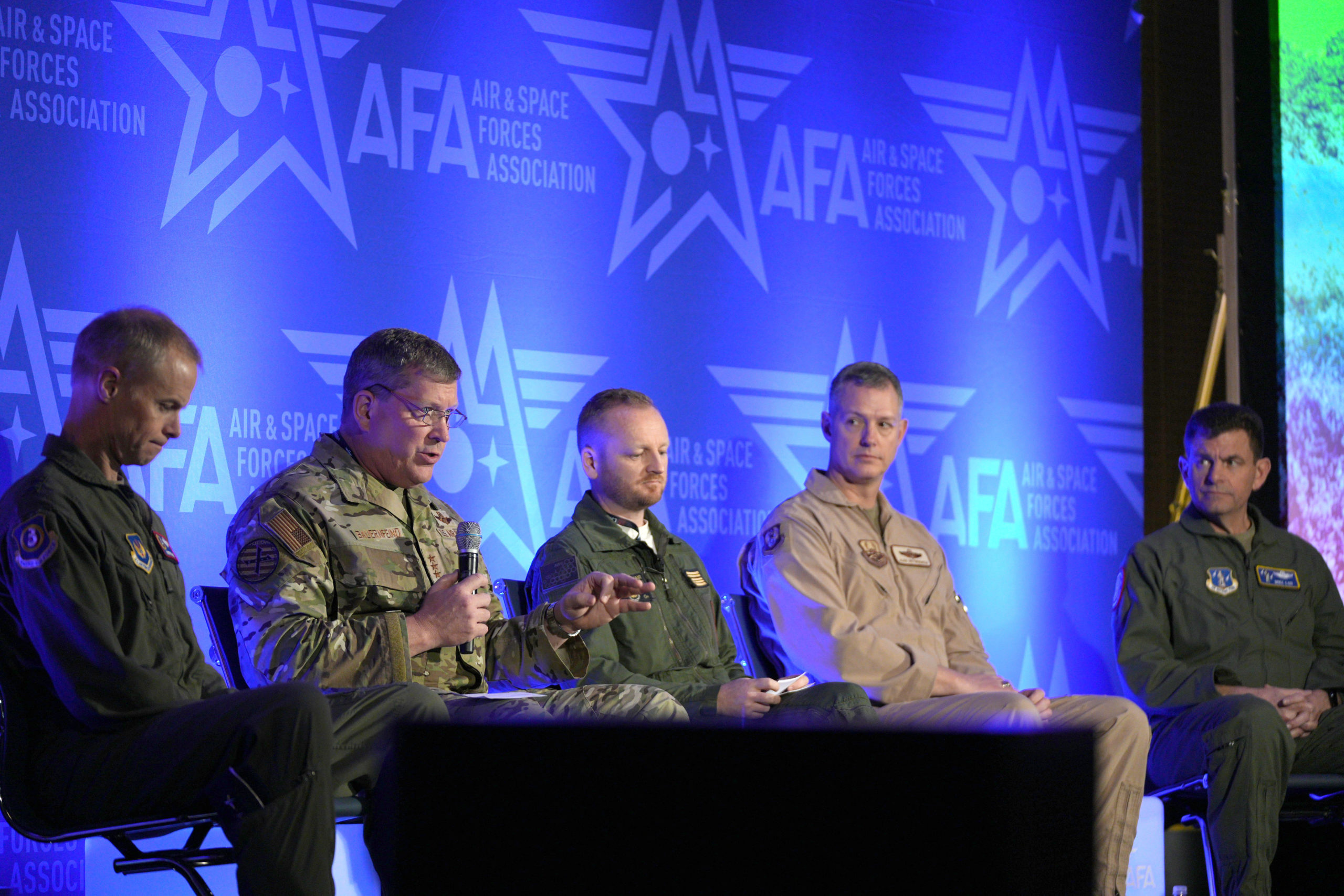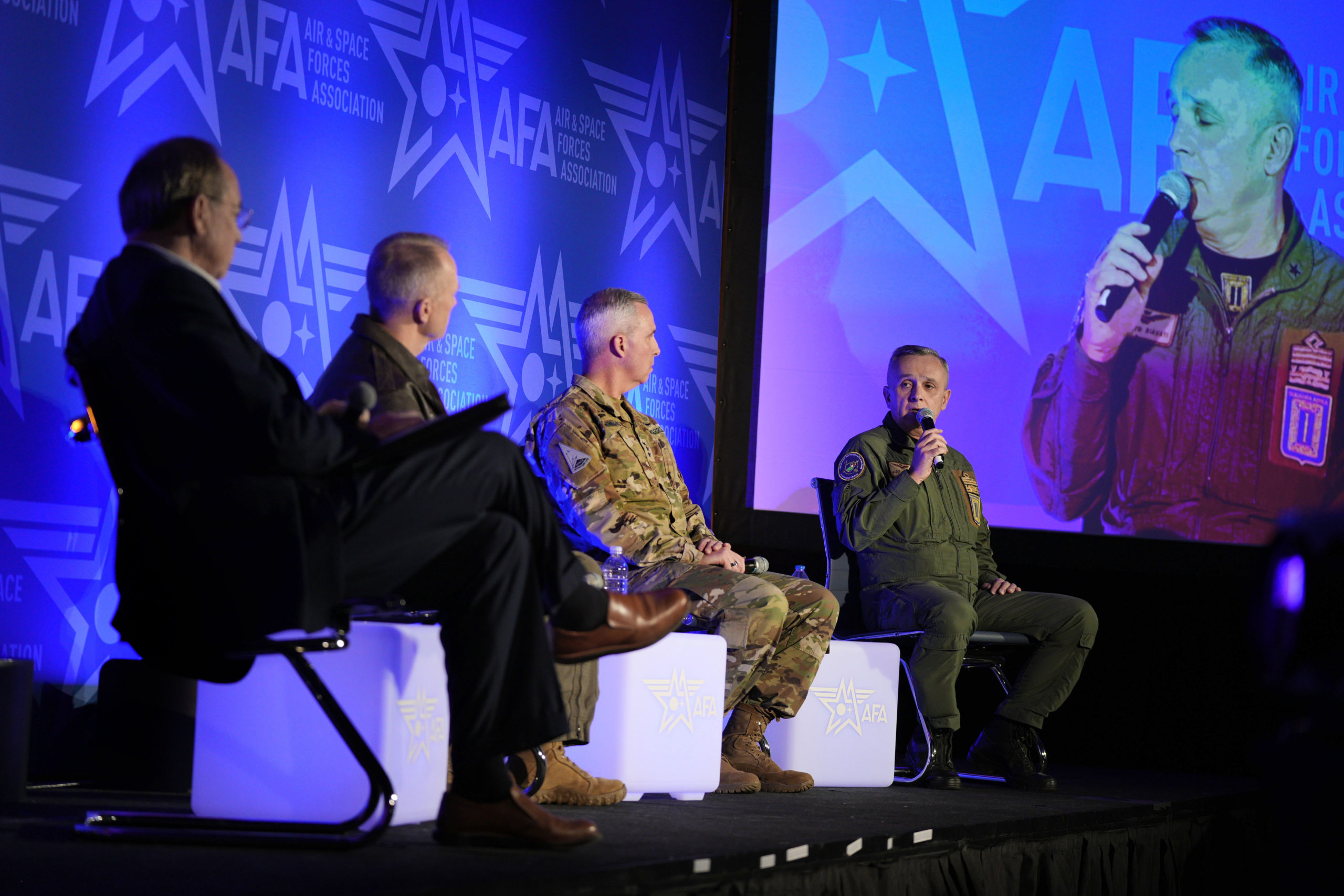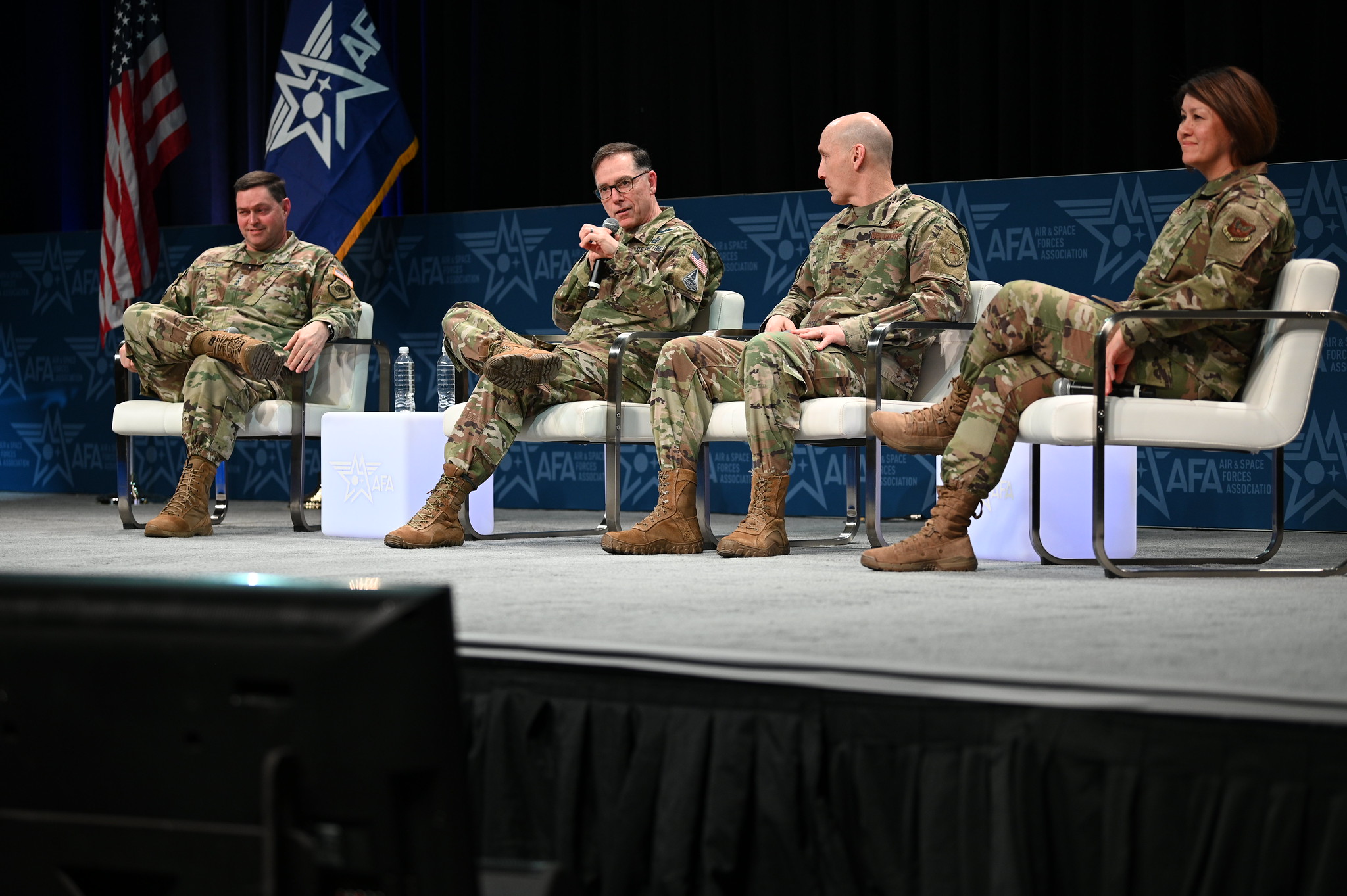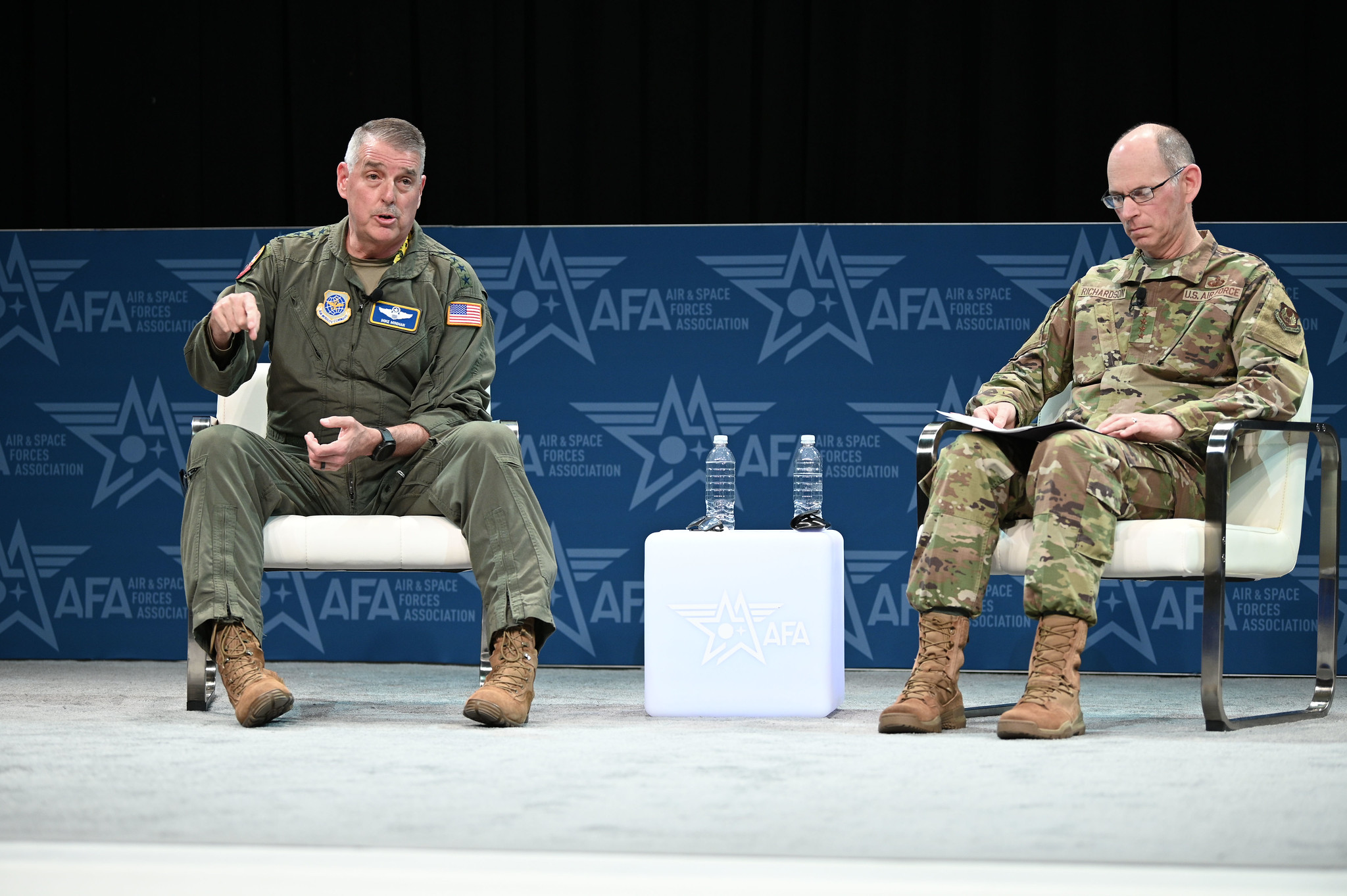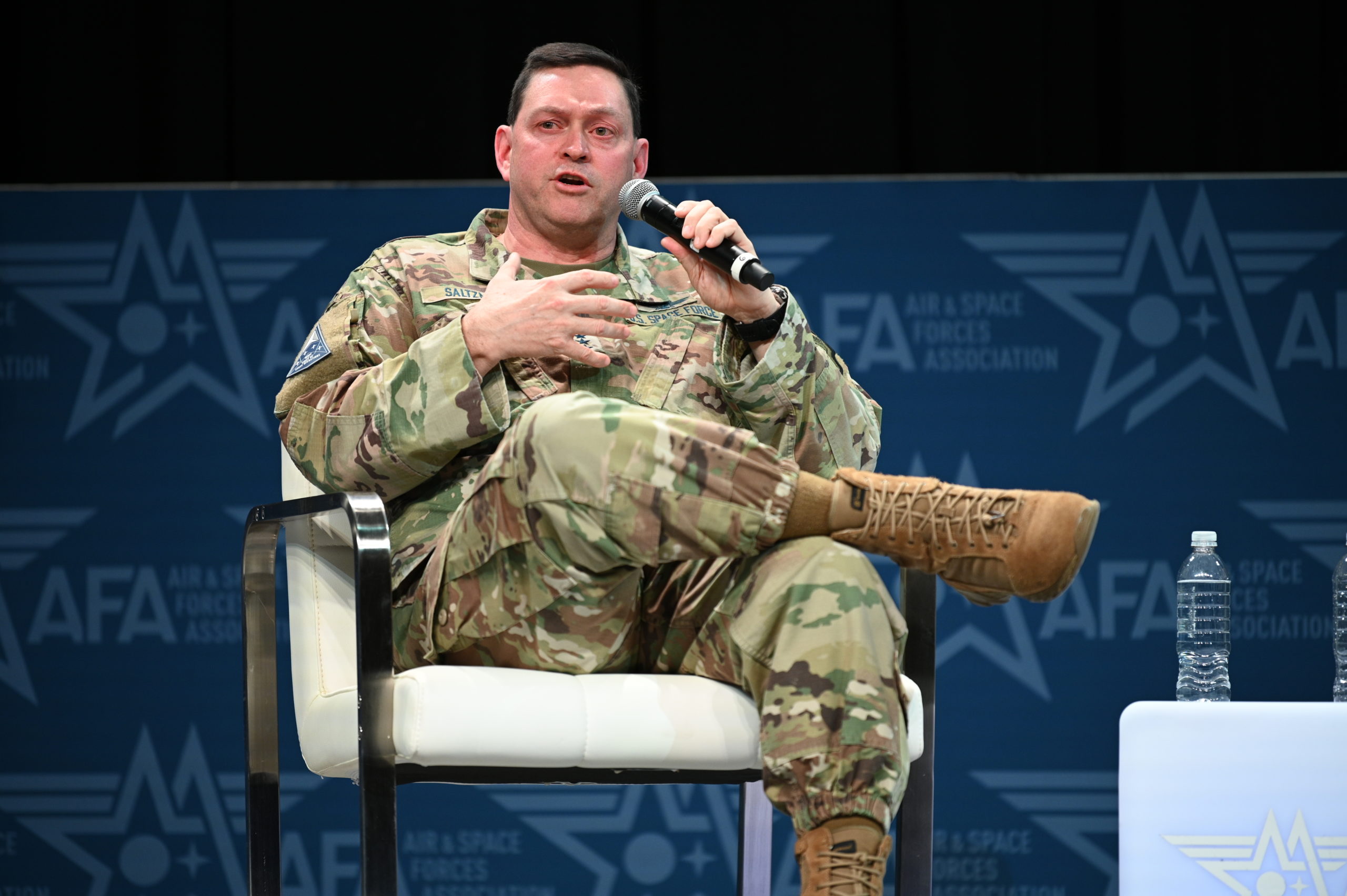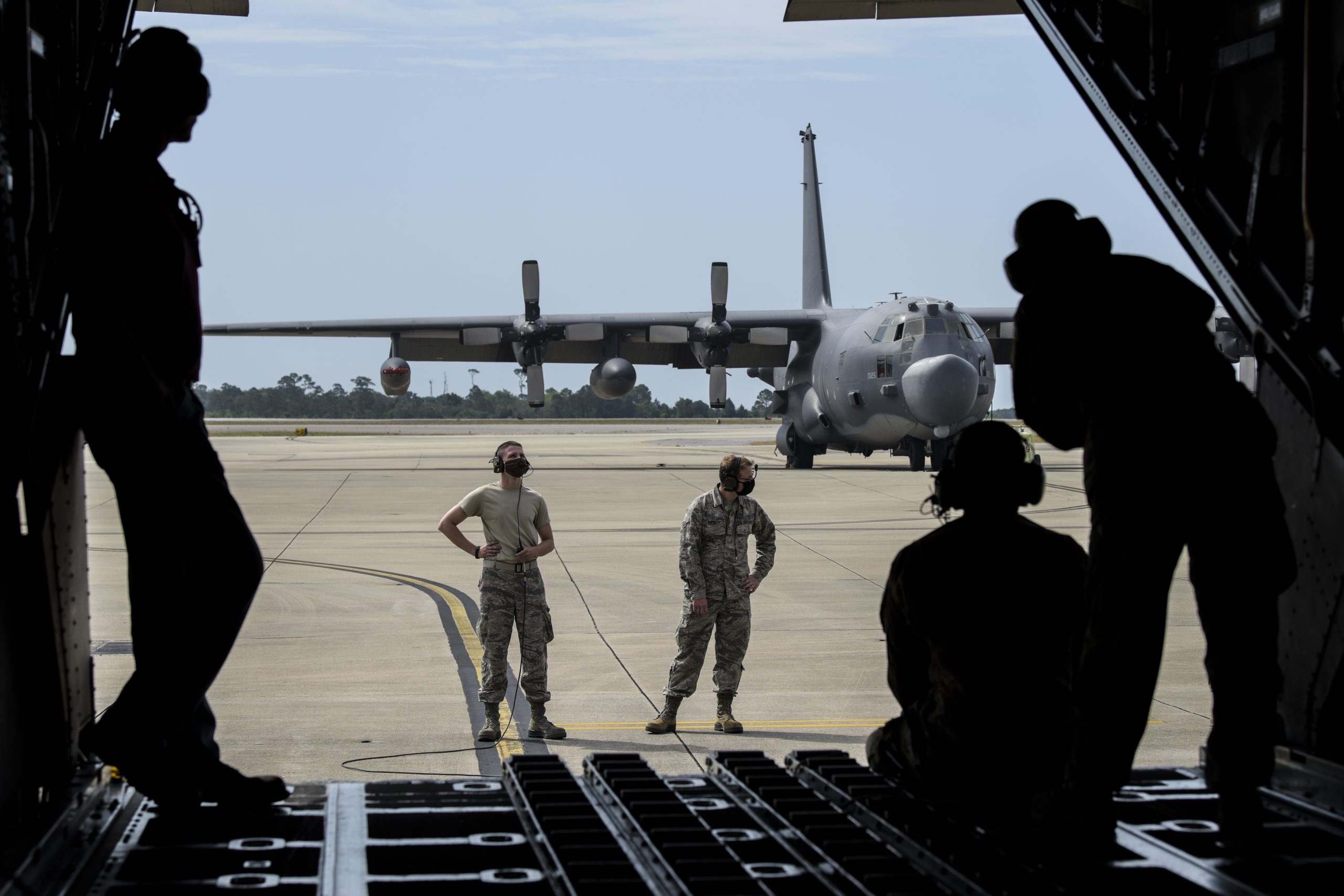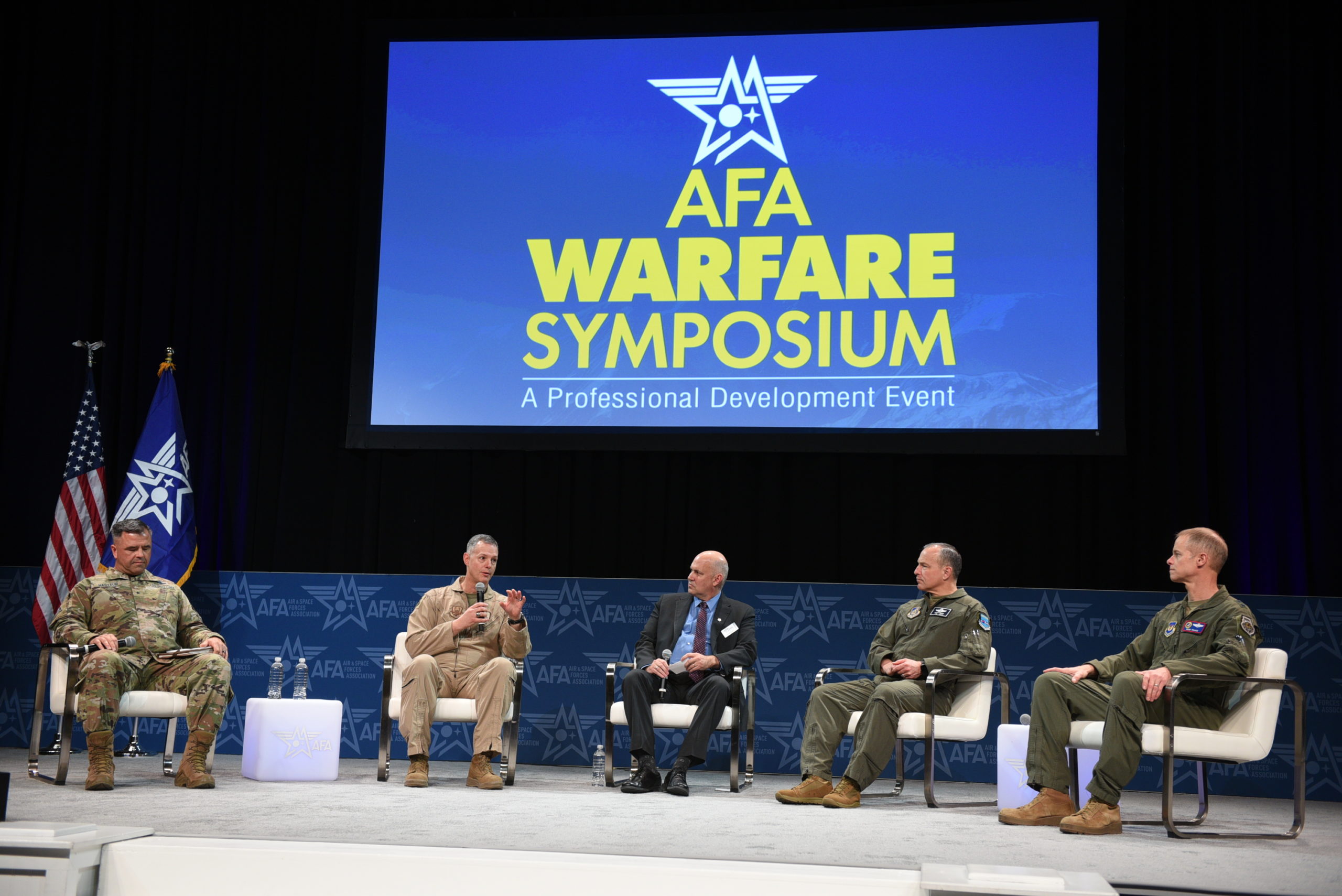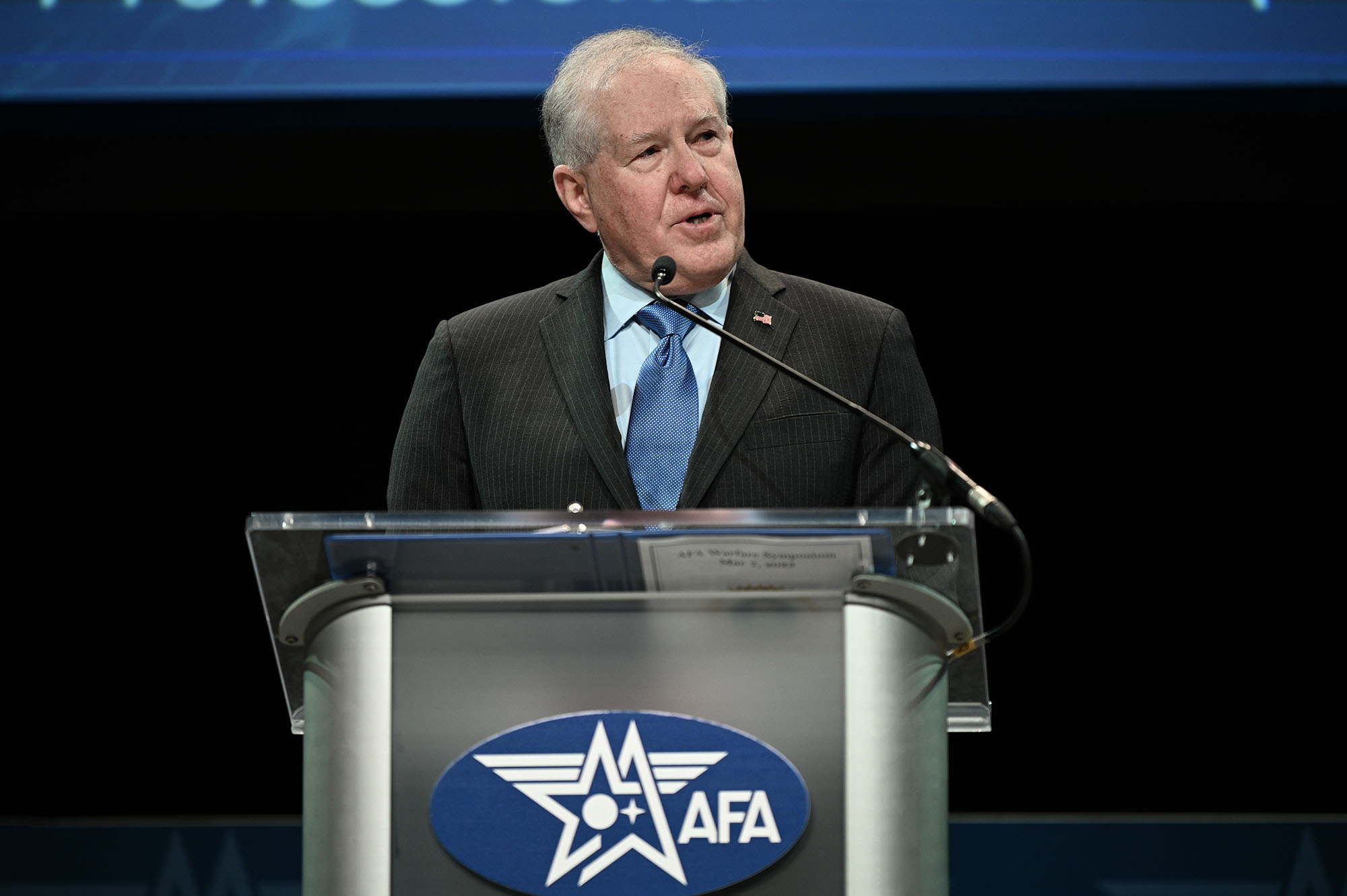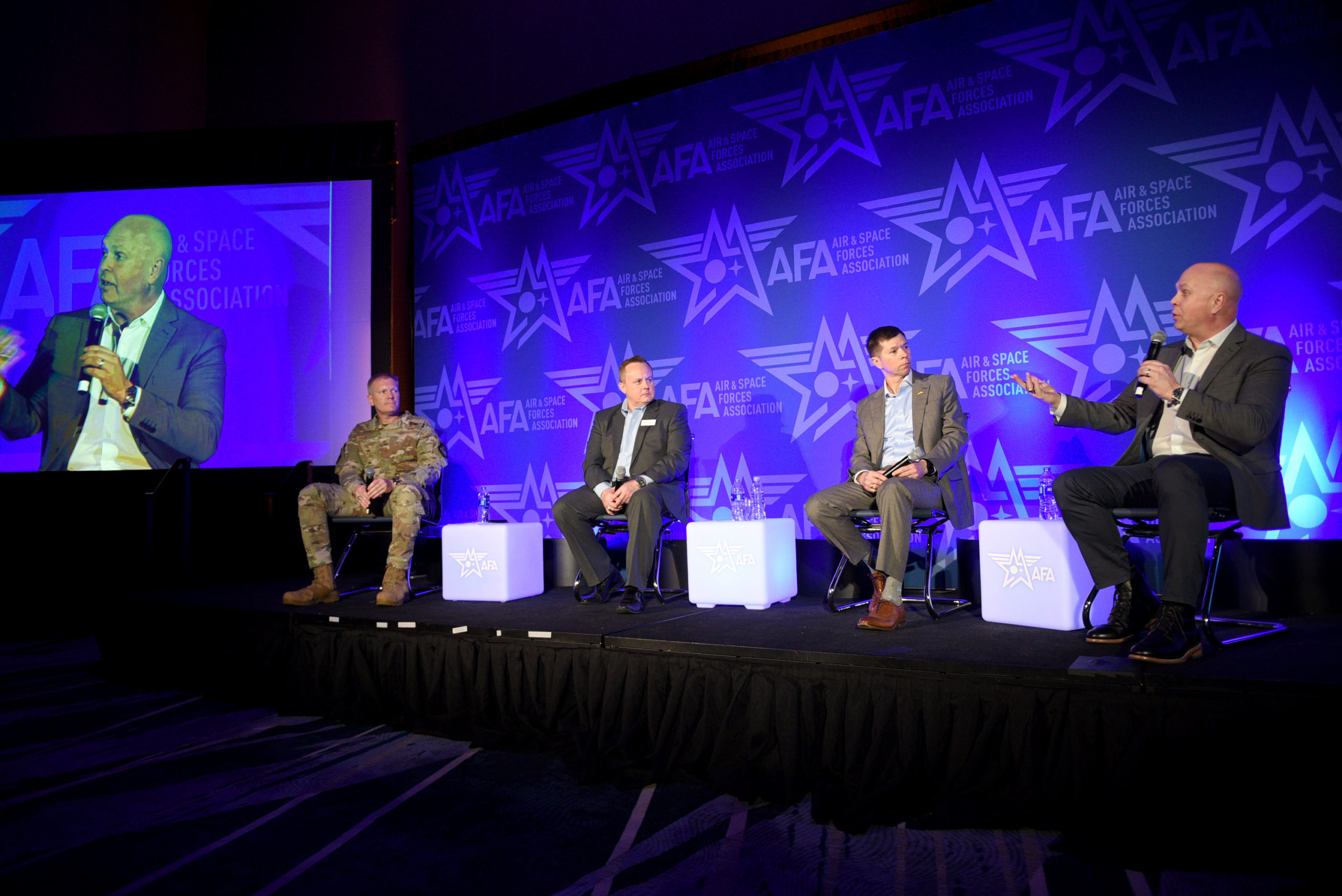Lt. Gen. Tony D. Bauernfeind, commander of Air Force Special Operations Command; Lt. Gen. Alexus G. Grynkewich, commander of Air Forces Central Command; Lt. Gen. Michael A. Loh, director of the Air National Guard; and Maj. Gen. Derek C. France, commander of the Third Air Force discussed both current and historical examples of the Air Force’s Agile Combat Employment concept and laid out how they plan to implement it during a panel moderated by Col. David Pappalardo, French Air and Space Attaché, on March 7, 2023, at the AFA Warfare Symposium. Watch the video or read the transcript below.
Col. David Pappalardo:
Good afternoon everyone. I’m Colonel David Pappalardo, the French Air and Space attaché in Washington, and this is my tremendous honor to moderate this panel on Agile Combat Employment today. So to dig into this issue, I’m lucky enough to sit in the middle of a fantastic alignment of leaders. Among them, we have a Major General France, a commander of the Third Air Force at Ramstein Air Force base in Germany. So, a little bit of echo. So as a US Air Force Europe and US Air Force Africa only numbered Air Force. The Third Air Force you can command, sir, empowers and advocate for 10 wings and more than 32,000 Airmen across two continents, which is an area of responsibilities that stretches from the Arctic to the Cape of Good Hope. And before switching to the other, considering your last name sir, for sure you will have the first and easy question. I saved the wicked one for the others.
I also have the pleasure to host Lieutenant General Bauernfeind, commander of air special operation command in Hurlburt Field, Florida. So AFSOC, the Air Force component for US Special Operation Command and provides Air Force Special forces for worldwide deployment and assignments to unified combatant commanders. If I switch to my left. I also have the pleasure to host Lieutenant General Grynkewich, who with the commander of the Ninth Air Force in AFCENT and also the combined force air component commander for US Central Command. So you are responsible, sir, for developing contingency plans and conducting air operation in a 21 nation area of responsibility covering central and southwest Asia. And last but not the least, Lieutenant General Michael Loh, with the director of the Air National Guard. You are responsible for formulating, developing and coordinating all policies, plan and program affecting more than 108,000 Air National Guard and civilians. You’re all welcome. It’s such a pleasure to have you. Before yielding the floor to you. Let me offer some context here on Agile Combat Employment.
So the panel’s title come with a question mark, Agile Combat Employment: are we ready? I emphasize the we since you may have noticed from my charming French accent that I’m not American, so I should should have said are you ready? But I emphasize the we for at least two reasons. First, I will discuss during the panel the role of allies and partners is critical to the successful implementation of Agile Combat Employment for the US. And second I say we because we might argue that ACE concept may not be new but for sure concern all the air force as a epitomized by the initial lessons learned from the air war in Ukraine. Amidst them, indeed is the relevance of a flexible and resilient basing strategy to mitigate the effects of Russian strikes. So to some extent the Ukrainian have applied [inaudible 00:03:55], the tenets of the American concept of agile combat deployment by randomly selecting, sorry, several air fields of deployment to complicate Russian targetings.
So to go back to the other side of the ponds and talk about the United States, we know that Air Force Secretary Frank Kendall list of seven operational imperatives unveiled in 2022 is also a call for resilient basing and that effort is closely tied to the service’s ACE concept in which small teams of Airmen and aircraft dispersed to remote austere and small locations and can move or operate quickly to create a lot of unknowns for adversary. So maybe start from the Air Force doctrine definition of a Agile Combat Employment, a proactive and reactive operational scheme of maneuver executed within threats timelines to increase your availability while generating combat air power. I think it’s a good start and we may start with you General France. So following on this definition, what is your perspective? What’s your vision? What is Agile Combat Employment, what it is really about and is that something really new or lessons we learn to edge against the return of high intensity warfare?
Maj. Gen. Derek C. France:
Thank you for the question and thanks for the audience for being here. I think to answer your question, is ACE new? It’s a new name for a concept that that’s been around warfare for centuries. I think some more recent historical examples of good and bad. If you think of the Six-Day War of 1967, an example of not good ACE by the enemies of Israel at the time and they lost a good chunk of their air force and it’s called a Six-Day War because oddly enough it lasted about that long. A positive example of ACE that we see from World War II that’s highlighted in the USAFE CONOP if you’ve thumbed through that is the Polish Air Force in World War II when they were attacked and had the foresight to move a lot of their air assets knowing that the airfield would be attacked and then had the ability to operate for several days, ultimately not prevailing in that conflict but exacting a loss on the German adversaries as they did that.
So I don’t think it’s new. I think this is something that has been around since, well before even air power, this concept of maneuvering to keep your enemy on the toes. What has changed, and I can speak to the European theater, is the number of bases that we operate from. So in 1980 we had 18 main operating bases, today we have six, rough math in public, that’s a third. Add to that the extended range of the threat that we face and the complexity and the precision of the threat that we face in the European theater and that really drives us to do something different than we have done and ACE is the answer as far as the situation we have now. In USAFE, we think of ACE really in three terms and while they’re proactive and reactive as you described earlier, we really think of it as ACE to defend, ACE to deter and ACE to win.
And so defending is kind of that reactive type of ACE where there’s a threat, we have indications and warnings, we get off the X, we put small footprints out for a short period of time to survive some sort of attack and be able to operate, but a very light footprint to do that. ACE to deter and I would caveat that by saying ACE to deter and assure our partners in the alliance is something that we would do in a much more methodical method and the footprint’s a little bit larger but still a light footprint and something that we could operate from and then ACE to win is in a full scale type of conflict where we’re actually doing sustained combat operations moving back and forth. I will say the challenges we have right now in USAFE are really, there’s several, the two biggest are how do we command and control theater wide ACE and how do we support it and sustain it, specifically within terms of weapons.
For command and control, we’ve done some experimentation at the theater level with the Air Operation Center, trying to command and control multiple ACE movements that are happening at the same time. And the tendency is if you just do one, the whole AOC looks at that ACE movement and they focus on it and it goes pretty well. When you do multiple ACE movements across the theater, the AOC is forced to get up to its doctrinal level of being operational command and control and we have to push some of those authorities down to the wings in their wing operations centers and the detachments that are often commanded by a field grade officer in a very small footprint and push that decision authority down to a lower level.
And so that is still work in progress and logistics is probably the highest hurdle of all that, so how do we sustain those forward locations either with prepositioned weapons and equipment or being able to move it across and in Europe we have a little bit of an advantage as far as we can use GLOCs, we can use ground lines of communication in shorter distances and things like that that I think is more challenging in different theaters for sure in the Pacific. So that’s a little bit about how we see historically and some of the challenges we see in USAFE right now.
Col. David Pappalardo:
Okay. We will have the occasion to come back on the challenges with other panelists and before turning to Lieutenant General Bauernfeind. So in Europe, so we talk about a little bit about the Ukrainians, but how that the Ukrainian Air Force strategy in the war against Russia shed light on ACE concept is that’s something that would change your perception about ACE?
Maj. Gen. Derek C. France:
I think the examples we’ve seen as far as the ACE concept that we’ve seen in the Russian invasion of Ukraine is twofold and I think you touched on it in your opening comments is we’ve seen ACE to deter from our NATO partners and from US assets where we take small footprints out into eastern flank airfields that we normally don’t operate from, but anywhere from Romania up through Poland, up through the Baltics. And while it’s conceptually a little bit different than how we envision ACE because it was a longer duration, they were out there for several months leading up to the conflict, a lot of the skillsets and a lot of the footprint is very similar to what we see an ACE kind of construct.
And so that deter and assure aspect of ACE is something that we saw play out. And while you could look at it and say, well we didn’t deter Russia from invading Ukraine, I would contend that there was a deterrence and assurance factor as far as NATO cohesion as the invasion happened and a deterrence from expanding the war further to the west. I think on the Ukrainian side we absolutely saw ACE to survive or ACE to defend moving assets off of their location both aircraft as well as some of their surface to air missile systems for that. And they’ve been fairly survivable and able to operate. They’re still taking combat losses in that war right now, but we don’t see mass losses on the airfield because they’ve been savvy enough to keep their aircraft moving around.
Col. David Pappalardo:
Thank you sir. Sir, I’m turning to you to some extent, AFSOC is a pioneer of the ACE concept, having been able to, for a long time now, to rapidly deploy an established forward operating location manned by multi-capable Airmen and commandos. Could you elaborate please on the contribution to the ACE concept to AFSOC, sir?
Lt. Gen. Tony D. Bauernfeind:
Thank you very much and first of all, thank you so much for MCing this great panel with these teammates and to the AFA for setting this up. And as we look at this, I would provide it from a few perspectives of what we’ve been contributing and I’ll put it into three as first is our mission sustainment teams and the concept I want first off is our multi-functional Airmen and air commandos and then finally mission command. But before I go into that, I want to reinforce the why and the why is if we look at the last three decades, our adversaries has been looking at the American way of war, what do we do? We power project, we established super bases, we establish our force, and once we’ve collected ourselves, then we proceed forward with our offensive operations and our adversaries have taken full note of that and they are going to attack our bases with quite an aggressive manner in that it’s a critical vulnerability that we have to, so we have to have these forces that can power project from locations and be able to shoot and scoot.
And what I mean is land, establish, generate combat power, prosecute missions, and as soon as we get an intel threat, we’re moving on to the next location and we’re constantly moving around theater and it’s important to understand the why and I want to reinforce the history as well as to say that we’ve been in this a while. We can trace this all the way back to World War II with where we kind of take our roots with Air Force Special Operations Command. When we look at what General Arnold did when our British teammates came to us and said, hey, we’re having a challenge getting behind Japanese lines in the China Burma India campaign. They came to General Arnold said we need help. And two colonels, Colonel Cochran and Colonel Allison moved forward with an operation known as Operation Thursday and 400 Army Air Corps Airmen moved forward, maintainers, services, medical personnel, enlisted pilots all moved forward for a glider invasion behind Japanese lines to establish that footprint for the follow on force of P-47s, of B-25s to really take the fight against the Japanese.
And I will not bother you with all the aspects, but nobody landed and said, hey, I’m just a maintainer, I’m only do maintenance. It was all hands on deck as they established that airfield and brought in combat air power and made it happen. And that has really informed us as we’ve moved forward, but we kind of had to reflect on ourselves because the last two decades of counter VEO, we got out of that mindset. We showed up with our operational forces and looked to the left, looked at our right of our teammates and said, okay, who’s going to support us? Who’s going to defend us? We’re going to generate the operational power on that, but we’ve returning to our roots and under General Slife’s great vision, we established what’s called the mission sustainment teams, that first aspect to bring to you that. These are 54 person teams primarily out of the mission support group of engineers, defenders, communicators, contracting specialists, service specialists that are bringing that capability forward to make sure that we can support and defend our operational units as they move out.
And I will tell you, our air commandos are absolutely loving it because they’re training together and they’re coming in and they are doing so much more than what they signed up for. And I will tell you from my perspective as we’re wrestling with the recruiting effort and our retention effort, these new teammates come in to do, they don’t come in to sit, they come in to do. And so that’s a big aspect, we’ve got to break down this mindset of, hey, you can only do one function. Our Airmen are so much more capable than a singular AFSC and we’re seeing it every single day as they move forward.
As an example, as we’ve exercised this into employment, we had a young services air commando that came in, became a part of the team, became so effective at what he was doing, became an air advisor through the process and as the mission sustainment team went forward, also started air advising Latvian teammates. Never in our wildest mind did we see services teammates doing that, but they rose to the challenge and it’s been exceptionally powerful. And then the final aspect that I think we’re getting after is mission command. Mission command is hard because for the last three decades we’ve been so centralized to General France’s great point on what the AOC does and doesn’t do. We’ve really got to get after the mission command aspect of future war fighting and it’s going to be hard on all of us, but we’ve got to embrace it. And I will tell you, we got to embrace it for a couple reasons. The first and foremost in all this is we have to feel comfortable telling our teams what they need to do and the why behind it. And we got to get out of the how.
They’ll figure out the how and they’ll figure out the how in ingenious ways. And so we got to get very comfortable in giving mission type orders, that’s critical to success in the future so that when those lines are severed, and I expect in the future fight as hard as we’re going to try to make sure it doesn’t, we will have teams that are not being communicated with and we’ve got to know that they don’t sit on their hands waiting to be told to do, that they continue to take the fight to the adversary. But the second thing is they’ve got to know that we’re empowering them with this decentralized execution. Not only empowering them but expecting them to do this. And through this they will build that mutual trust. And the final aspect that we’re focusing on with the mission sustainment teams is you can’t generate this on a moment’s notice.
We’ve got to pull these teams together and they’ve got to train themselves as it goes forward. And what we’ve learned through this process is as we pull them out of the units, we’re actually assigning them to a team inside the operations group and they go through an 18-month workup and the mutual trust they benefit from that is exceptionally powerful and we’re seeing great success as it moves forward and we’re going to double down on that, not only in the active force, but we’re getting great support from our total force teammates as they’re leaning forward into the mission sustainment teams as it goes forward and we’re excited to see where it goes. But the final thing I want to push on is also the feedback that we’re seeing in it, the air commandos that are part of these mission sustainment teams are absolutely loving what they’re doing because they’re out, they’re tied to a mission and they’re tied to a team and they’re seeing great rewards from that.
And at times, to be quite honest with you, we’re seeing teammates are going, we want to keep doing this, but we’re having to go, nope, you’ve now completed mission at the 24-month point, we actually need you to go back to the garrison so that you continue to progress in your AFSC as it goes forward. We got to keep both balances going. And that’s the second friction point that we got to highlight in all this is what I call the garrison trap. And what I’m seeing with our teammates and the wing commanders is where is it most important to take risk? Because as we have developed these mission sustainment teams, it’s all under the auspices of we’re getting no additional manpower, so we’re taking this out of hide.
So where are you going to take risk? And are you going to take risk in your war fighting capabilities? Are you going to take risk in your garrison responsibilities? And those are tough conversations to have, but I will tell you the nation’s expecting us to fight those war fighting capabilities. And the final thing I want to double down that General France already did is we’ve got to be serious about exercising logistics. For way too many years, we have simulated away the exercising of our logistics and I think that what we are seeing from the Ukrainian fight with the munitions expenditures, with the logistics shortfalls that they’re seeing, we will see very similar problem sets unless we get serious about exercising those requirements we will need for the logistics as we move forward and looking forward to our industry teammates bringing forward new capabilities to help us with that. But a short snapshot of where we’re going, but exceptionally excited to see where our air commandos are going in this.
Col. David Pappalardo:
Okay, so what I’m taking away is capabilities, of course, multi-capable Airmen, mission command, teamwork and of course exercise and training and training and training. You mentioned a little bit about, I stay with you a little bit, but you mentioned about capabilities, but do you foresee any further need, new needs for capabilities to implement ACE concept or what you just described before is enough?
Lt. Gen. Tony D. Bauernfeind:
Yeah, a couple things. I think we have to have a conversation of what capacity of this capability do we want in our air force right now inside of AFSOC, I realize that we are a very unique part of the Air Force. We are right now able to generate three active duty MSTs and potentially one to two total force mission sustainment teams as it goes forward. But what will the rest of the Air Force be able to generate and move forward as we go into this regards if the whole of the Air Force goes out. So we have to have a serious conversation of what’s that capacity requirement and then also it’s going to lead into potentially new organizational structures. In AFSOC, we’ve established it inside of hey, these great air commandos that are inside the mission support group when they generate, they become part of the ops group and become an operational deployment as it comes forward, is that the right way to go forward for the rest of the force?
That’s a conversation we need to have. But on the, I would say the what capabilities we need industry to bear on this is at the end of the day we’ve got to be lighter and leaner across the force. We’ve got to have C4I systems that fit in a backpack not on a 463 L pallet and be able to communicate globally with multiple channels as it goes forward with multiple waveforms, multiple encryptions and multiple antennas as it goes forward. We’ve got to really dig into what is contested logistics going to be like. We really haven’t had to wrestle with that in the past two decades. The biggest challenge on logistics is going to be is a hey, is it going to clear customs at Qatar as it comes forward versus the, hey, how are we truly going to get the capabilities we need forward?
So what are we going to do for water generation, fuel generation, energy generation, 3D printing as we go forward? Because we’re not going to have the luxury to MICAP parts all the way at the leading edge where many of our forces are going to be and we’re going to have to enable our Airmen to be successful as it goes forward. And then finally, the capabilities we’re going to have to have is that mobility aspect to be able to move quickly and what we’re calling is runway agnostic operations. While will always benefit from great FOBs that will enable the greater force roll in on, we at AFSOC are looking at capabilities that almost make the runways agnostic. Things like high speed vertical takeoff and landing that have a theater dash capability, but that terminal area flexibility where you can land anywhere. For maritime operations as we’re looking at an amphibious C-130 type capability to make sure that we can move around the battlefield where we need to with the ultimate goal of just giving more and more dilemmas to our adversary.
Col. David Pappalardo:
Thank you sir. I’m turning to you Lieutenant General Grynkewich. So the implementation of ACE is not without challenges. Our two previous panelists mentioned some of them, be it in terms of logistic on training, on war reserve material per se. Could you please give us some examples on how the Ninth Air Force intend to face these challenges in your responsibility?
Lt. Gen. Alexus G. Grynkewich:
Yeah, you bet. So thanks for monitoring this panel and you actually made my job really easy because I’ll just say what they said but what I’ll try to do is give you a couple of specifics and fill-ins on how Ninth Air Force is thinking about this, but I could not agree more of the three main points that have been highlighted here. Training and exercises, you’ve got to practice this stuff over and over again. Logistics/sustainment and command and control. So couple things on training and exercises, in AFCENT today, right now we’re executing a theater wide Agile Combat Employment exercise called Agile Spartan. All of our air expeditionary wings are participating in this and basically we’re dispersing the force to a number of different locations across all of the countries in the region where we operate. This allows us to do a couple of things.
The first is in an austere combat environment where we’re generating combat sorties to go up over Iraq and Syria, we’re able to do things like integrated combat turns, load live weapons, make sure that we’ve got real gas that we can load up and, no kidding, generate combat power and operate and we’re going to be doing this for a few weeks. So it’s not just going cross country for those air crew members. I mean the ops and maintenance teams out there, aircrew and maintainers can go somewhere on austere location and launch a jet. It’s sustaining that over time that really becomes challenging, especially when you’re talking about all the different things that you need. Gas, food, weapons, et cetera. So it’s a great opportunity for us to do that. It then gives us insight into the command and control aspects of this. And I could not agree more with my friend Trapper France that you have to get the Air Operations Center at the right level of warfare.
And the way I think about it, for too long I would say, and AFCENT has been part of this, the definition of command and control and how we thought of it was just with an air operation center and the CAOC at Al Udeid. What we really need to think about as an Air force is command and control at echelon. And one of the quotes that a mentor of mine once said is, “I’m always in command but I’m not always in control.” And I think that’s really important, we’ve got to be willing to recognize that we can’t control everything from Al Udeid or any other AOC anywhere in the world and we need to think about building mission command nodes at echelons at the wing level and all the way down to the squadron level as you disperse these detachments out across cluster bases. So from a C2 perspective at AFCENT, what we’ve done is we have a cluster of bases and each air expeditionary wing commander owns that cluster of bases and they’re responsible for filling the ATO from that base cluster.
And I’m not going to tell them what base to generate from. I’m not going to tell them what base to land an aircraft at. I’m just going to tell them what mission it is that they need to fill and they need to get that line where it needs to go. But if I try to manage their cluster base, I won’t have the situational awareness as to how much gas is at a location, are the right munitions there or not, that’s all going to be managed at echelon, a lower echelon, not a higher echelon or we’ll fall on our faces in my view. And the last thing I’ll say about it is we sometimes talk about this concept of mission command as something that only applies when the comms go down. I would tell you that from my perspective, the concept of mission command is just as important when the comms are up and we will have a tendency to get into each other’s chili, we’ll have a tendency to use a 2000 mile screwdriver and start micromanaging.
But the moment we do that, we’re taking away opportunity space from Airmen on the front lines who are able to see an opportunity, seize that opportunity and gain a decisive advantage when we try to manage it from somewhere else. So we’ve got to be comfortable that we’re not controlling it, we’re just commanding it. The last point I’ll hit on is logistics. So the concept of using ground lines of communication works in Europe, absolutely essential to us in AFCENT having logistics readiness, squadron commanders have to figure out how they’re going to move a ground convoy and shuttle equipment from location to location, still dealing with customs at the border as you go say from Israel to Jordan. I mean huge challenges that you have to work through, again, at the squadron level, they’re able to pull this off. That’s the long-term sustainment, but you’ll still have things that you have to get very quickly to a location, maybe it is MICAP part that you can’t 3D print or something along those lines.
So we have a new concept that we’re working on with Air Mobility Command and our DIRMOBFOR and the air mobility division in the AOC, an agile airlift cell that is working to be in direct support of wing commanders rapidly allocating tactical airlift to get emergency supplies, emergency equipment, a shipment of weapons that wasn’t where it needed to be shuttled between locations as quickly as possible, so those are just some of the things that we’re doing.
The very last one I’ll say is, and you mentioned WRM in your question, all of us have big piles of WRM at main operating locations and it’s very efficient from a money standpoint and a personnel standpoint to manage things that way. What we’re doing in AFCENT is looking at based on indications and mornings and the road to war, to major combat operations, where is the trigger point where you need to start dispersing that WRM and setting yourself up for ACE? That’s going to be an expensive trigger point to execute, it’s going to be a DP that’s going to send a signal for deterrence, but it is something that you got to think through because that WRM will not do you any good if it’s just sitting at Al Udeid. Thanks.
Col. David Pappalardo:
Thank you very much sir. So time flies, so time is now for our last question and it’s very frustrating not to have extra time by the way. But anyway, so I recall Northern Agility 22-1, which demonstrated the US Air Force Agile Command Employment Doctrine and ready to execute missions quickly in unpredictable ways like having some National Guard assets taking off from and performing integrated combats on the close 9,000-foot section of Michigan Highway M-28 was very impressive. More in detail sir, for the very last question, can you explain how the Air National Guard is preparing for ACE? Thank you.
Lt. Gen. Michael A. Loh:
Yeah, sure. Team, really quick because those in front can’t see ya. We got standing room only in the back. I mean our Airmen are excited about ACE and whether you’re in the active component, the guard or the reserve, we’re all doing the same thing, how do we operationalize the national defense strategy? Part of that for the Air National Guard is recapitalization both in mission and equipment. The second piece is innovation, which ACE fits under and the third piece is engagement, which also ACE fits under. It’s how do we engage our allies and partners in this thing. The one you mentioned was our fourth generation and I call it exercising, every unit is out there exercising, whether you’re in KAF, MAF, AFSOC, they’re all exercising this, they’re all getting evaluated on it for every time we go out and we deploy. I’ll give you just a couple of examples of what we’ve done this past year and I think it’s important.
First off, I’ll start with our legacy systems, the mobility platforms. KC-135 ACE, within 35 days we brought Airmen, soldiers, sailors together. We launched a KC-135 with two razors in the back with a small ground battle management C2 system in those razors, 31 Airmen, two pallets. Unloaded it all, figured out how to set up a FARP, how to actually get gas off of KC-135, a 62 year old airframe with the right configuration and feeding those lessons learned into weapons and tactics, we set up a mobile ground system, a network that both went over the horizon and that to do C2 at the edge. And we actually did real time targeting both for sensors that were airborne and also sensors that were over the horizon using some other national technical means. Very powerful and how do we get after this? With a very small team, but that was a joint team.
It’s also nice when in the Air National Guard, I can go to my Army National Guard brethren, some of our SOF forces like 19th special forces groups and 20th special forces groups and grab their razors and their expertise. So that’s the legacy side and how we’re going to get after it and what is the ground time on a 135 because I can land it, I can get gas off it quickly and now we can get out there, all those are feeding back. The one you mentioned is fortune, it’s we had never hot pit refueled an A-10 on a highway in Michigan and the Airmen didn’t know how to do it actually because they had done it off a truck. We were doing it off of an Army National Guard FARP location. And so we had a Army National Guard specialist teaching our Airmen how to actually take an A-10 and refuel it in a hot pit in there.
And so that’s the experimentation side and how we’re doing that stuff. And then fifth gen and Trapper, I’m going to use the example of USAFE and I’m going to say it this way, because General Hergan at one of our meetings last year went, “Hey, Mike, your F-35s that are operating over there.” He goes, “I know ACE is working because I don’t even know where they are in theater at certain times.” So what was allowed over there when the F-35s deployed over to Europe was an example of fifth gen. Think about all the stuff that goes into fifth gen.
And we sent six F-35s with 35 Airmen, so less than six Airmen per tail. That’s officer and enlisted operated out of a non-US base in Estonia for five days, did over 300 maintenance tasks, set up lightning rods, tracked over 5,000 tools and delivered combat power and very small teams to do exactly what General Hergan at the time needed, which was, hey, what can I do up in the Baltics and how can you help me out? So using our innovation for Agile Combat Employment and multi-capable or multi-functional Airmen as General Bauernfeind so says we can do that with the small teams and the experience of the Air National Guard and also those partnerships that we’ve established throughout the world, like in the state partnership program to get after that access basing and over flight and actually do some of that training and combined training to get after it and I think that’s how we’ll operationalize the NDS and be able to survive.
Col. David Pappalardo:
That’s a good and wonderful way to conclude this panel. Please join me to give a wonderful round of applause to our panelists and thank you very much.
